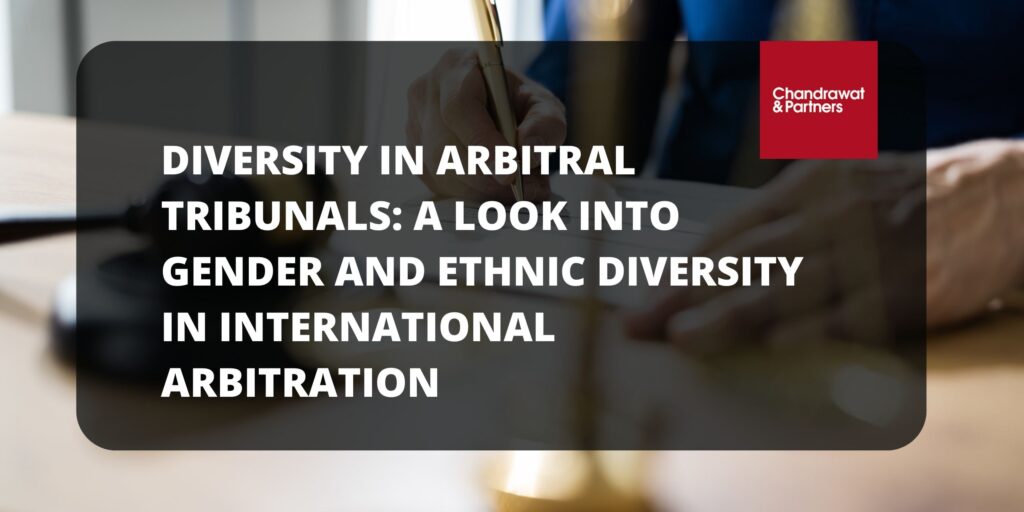Diversity in arbitral tribunals: A look into gender and ethnic diversity in International Arbitration
The diversity debate in international arbitration has largely remained uniform, concentrating on the need to give arbitration professionals from historically underrepresented groups. As society grows more global and disruptive forces drive ongoing innovation in how we conduct business and communicate, it is clear that people in high positions must reflect the variety of the communities they serve. Given the rising regional and sector variety of parties and the ever-expanding scope of conflicts, which have been brought to arbitral courts for settlement throughout the world, the rationale for diversity is arguably even more compelling in the context of international arbitration.
Arbitral institutions are no exception to this notion, and diversity as a concept is only to be encouraged for flourishing trends within arbitral institutions. The lack of diversity in international arbitration can be attributed to a number of factors. The “chicken and egg” paradox is possibly the most important explanation. That is, international arbitration assignments are difficult to come by without experience, and experience cannot be gained without being appointed as an international arbitrator.
Necessity of diversity in arbitral tribunal
Arbitrators of different gender identities, racial and ethnic backgrounds, and sexual orientations should have a seat at the table. There are tangible benefits of diversity, including navigating various nuances and understanding certain diverse viewpoints.
Diversity in an arbitration tribunal is integral to the credibility of the panel. This adds a unique perspective gained from each diverse region to the issue and helps in the redressal of the dispute. Diversity does not limit itself to just a panel of judges but also includes the parties, the counsel, and other players of the arbitral institution.
The need for diversity in arbitration institutions is to enhance the representation and talent on the panel. If there was a member on the panel from the region of the parties, this would help him understand the dispute better. Gender diversity is given the least importance among other diversity factors.
Gender diversity in arbitration appointments
The appointment of women arbitrators has been at the centre of the arbitration community’s diversity. An increased gender awareness among arbitration users may incentivize a more systematic approach to arbitrator appointments, where all qualified candidates are considered, regardless of gender. In recent years, a more conscious effort has been made to appoint a greater number of women as sole arbitrators. This step was taken by the Stockholm Chamber of Commerce Board. Interestingly, there was no fee discrepancy among women and men appointed as sole arbitrators.
Relation between diversity and efficiency of the arbitral tribunals
- Heterogeneity: It brings a more diverse perspective to decision making: combining the experience of arbitrators from diverse backgrounds with a varied approach to decision making can help improve decision-making significantly. Arbitrators from a single region would lack experience and legal knowledge of other regions.
- Legitimate decisions: The legitimacy or credibility of any institution working at any level is important for decision-making. The legitimacy of the decisions of a decision-making body could not be judged alone by its application of the rule of law and principles of natural justice. The need to recognise the diversity deficit becomes essential.
- Sustainable system: With diversity being introduced to the system, a greater number of people would get the opportunity to be employed in the tribunal and contribute to a speedier process. This will also give clients a more extensive choice, relieve stress in the form of workload, and make the decision-making process cheaper and faster.
Positives of diversity in arbitral tribunal
The parties must feel adequately represented in an international arbitration panel because they themselves come from varied backgrounds. Diversity is crucial for the tribunal to operate in an accountable and effective manner. It provides the decision-making process a fresh viewpoint. According to research, female gender attributes improve the quality of the verdict, which further boosts the tribunal’s effectiveness.
The ICC statistics state that 2020 saw “1,520 appointments and confirmations…with arbitrators coming from 92 countries and comprising 23.4% women arbitrators appointed or confirmed”. In terms of nationalities, the highest percentage of arbitrators came from the UK (14.5%), followed by the US (10%), Switzerland (8.9%), and France (6.6%). More than half of the arbitrators on ICC tribunals in 2020 (52.3%) were from North and West Europe.
The London Court of International Arbitration’s (LCIA) casework report for 2020 also notes that “the overall percentage of female arbitrators appointments reach[ed] a high of 33% in arbitrations pursuant to the LCIA Rules, a growth from 29% in 2019”. In terms of nationalities, the report stated that, “37% of appointments comprised appointments of arbitrators from 40 different countries, with the next highest numbers of arbitrators [after British arbitrators] being from Canada, the United States, Ireland, Germany, and Mexico”.
The caseload statistics for 2020 published by the Singapore International Arbitration Centre (SIAC) notes that “[o]f the 143 arbitrators appointed by SIAC, 46 (or 32.2%) were female”.
The annual report published by the Hong Kong International Arbitration Centre (HKIAC) in 2021 states that “[o]f the 149 appointments made by HKIAC in 2020, 34 (22.8%) were of female arbitrators”. The percentage of female arbitrators appointed by parties in HKIAC arbitrations was much lower at 11.1%.
Among the various compositions of diversity with regard to arbitration, gender diversity attracts considerable attention. It would be safe to say that efforts are being made to ensure gender diversity coming from different actors taking part in arbitration. In some cases, as a direct result of the ERA (Equal Representation in Arbitration) Pledge, most major international arbitral institutions now routinely publish statistics on the appointments of female arbitrators.
The aim behind this is that increased reporting and transparency in relation to female arbitrator appointments will bring with them accountability and be an effective driver of change. As regards geographical diversity, this kind of diversity may be ensured through the appointment of arbitrators from various geographical areas and with different legal backgrounds.
For more information or queries, please email us at
[email protected]





